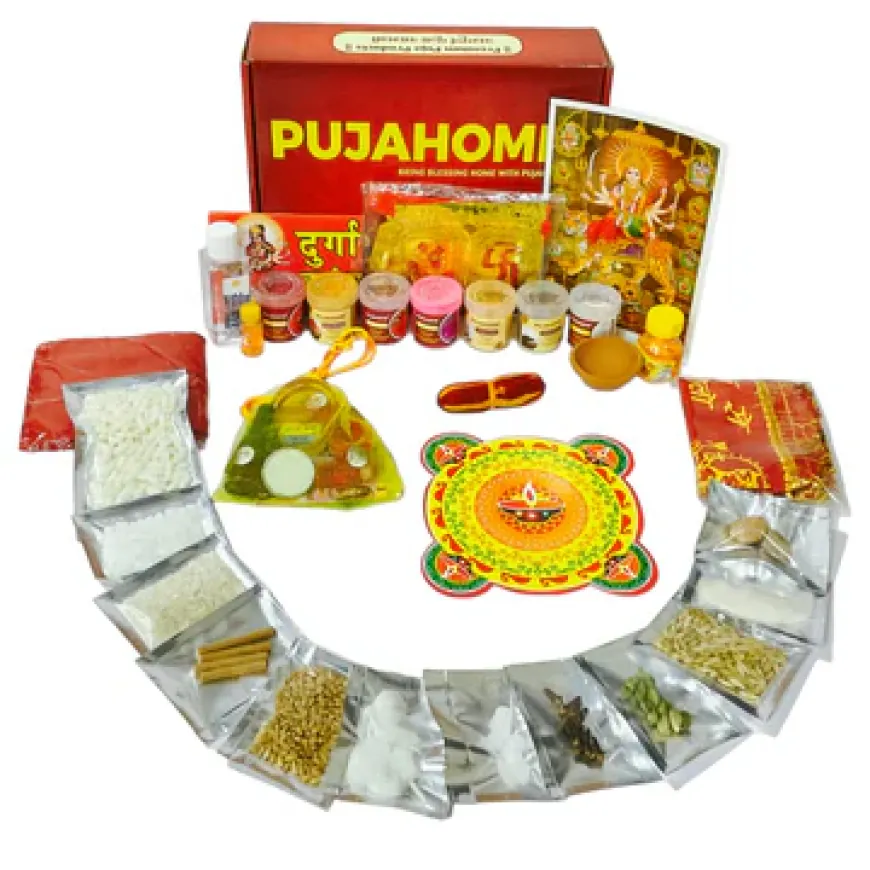Durga Puja Samagri: Essential Items for a Memorable Celebration
Durga Puja is not just a festival; it’s a celebration of cultural heritage, community bonding, and spiritual devotion. Gathering the right Durga Puja samagri

Durga Puja is one of the most significant festivals in India, especially for the people of West Bengal. This vibrant celebration, which honors the goddess Durga and her victory over the buffalo demon Mahishasura, is marked by elaborate rituals, colorful decorations, and community gatherings. To ensure a meaningful and smooth celebration, it is essential to gather the right Durga Puja samagri (materials). This article will guide you through the essential items needed for a successful Durga Puja.
Understanding the Significance of Durga Puja
Before diving into the samagri, it’s essential to understand the significance of Durga Puja. The festival typically spans ten days, culminating in Dashami, when the idol of Durga is immersed in water, symbolizing her return to her celestial abode. Each day of the festival holds special importance, with various rituals and offerings made to the goddess.
Types of Durga Puja Samagri
Durga Puja samagri can be categorized into several groups based on their use in rituals, offerings, and decorations. Here’s a comprehensive list of the essential items you will need:
1. Puja Samagri
This includes all the items required for performing the puja rituals:
- Idols: A beautifully crafted idol of Goddess Durga, typically made of clay or plaster.
- Kalash (Pot): Used to hold water, symbolizing the goddess’s presence.
- Rice (Akshat): Uncooked rice is often used for offerings and is considered auspicious.
- Flowers: Fresh flowers, especially marigolds and hibiscus, are essential for decoration and offerings.
- Fruits: Seasonal fruits like bananas, apples, and coconuts are offer to the goddess.
- Sweets: Traditional sweets like sandesh, rasgulla, and barfi are essential offerings during the puja.
- Kumkum and Chandan: Red vermilion (kumkum) and sandalwood paste (chandan) are used for tilak and rituals.
2. Aachaman Samagri
Before starting the puja, it is customary to purify oneself with aachaman, which requires:
- Water: A small container of water.
- Tulsi leaves: For purification and auspiciousness.
- Copper vessel: Traditionally used for aachaman rituals.
3. Decorative Items
The ambiance during Durga Puja is vibrant and festive, necessitating the following decorative items:
- Torans (door hangings): Made of flowers, mango leaves, or colorful paper.
- Lights: Decorative lights or diyas to illuminate the puja area.
- Rangoli materials: Colored powders or flowers to create beautiful patterns at the entrance.
4. Puja Thali (Puja Plate)
A puja thali is essential for organizing all the offerings neatly. It typically includes:
- Diya (lamp): For lighting during the rituals.
- Incense sticks (agarbatti): To create a fragrant atmosphere.
- Bell: Used to signal the start of rituals and prayers.
5. Clothing and Ornaments
Special attire is worn during Durga Puja, both for the devotees and the goddess:
- Sarees: Traditional sarees for the worshippers and new sarees for the goddess’s idol.
- Jewelry: Traditional jewelry for adorning the idol, including necklaces, bangles, and earrings.
6. Food Items for Prasad
Prasad is the food offer to the goddess, which is later distributed among devotees. Essential food items include:
- Khichuri: A traditional dish made of rice and lentils, often prepared during the festival.
- Lentils (dal): Used in various offerings and preparations.
- Vegetables: Seasonal vegetables for making curries or side dishes.
Setting Up the Puja Space
Creating a serene and sacred space for the Durga Puja is vital. Here are steps to set up your puja area effectively:
- Clean the Space: Ensure the area is clean and clutter-free to invite positive energy.
- Place the Idol: Set the idol of Goddess Durga at the center, preferably on an elevated platform.
- Arrange the Samagri: Organize the samagri neatly on the puja thali, ensuring everything is within reach.
- Decorate: Use flowers, lights, and rangoli to enhance the festive atmosphere.
- Prepare for the Aachaman: Keep water and tulsi leaves handy for purification before starting the rituals.
Rituals and Offerings
The rituals performed during Durga Puja vary by day and tradition. Here are some common practices:
- Sashti: The festival begins with the invocation of the goddess, where offerings of sweets and flowers are made.
- Mahalaya: This marks the beginning of Durga Puja, where rituals are performe to pay homage to the ancestors.
- Nabami: On this day, the main offerings are made, often including a grand feast for the goddess.
Conclusion
Durga Puja is not just a festival; it’s a celebration of cultural heritage, community bonding, and spiritual devotion. Gathering the right Durga Puja samagri is crucial for honoring the goddess and ensuring that the rituals are performed correctly. With proper preparation and an open heart, you can create a memorable experience for yourself and your loved ones during this auspicious time. Whether you're participating in community celebrations or observing at home, the spirit of Durga Puja is one of joy, reverence, and unity. Embrace the festivities and let the goddess's blessings illuminate your life!
What's Your Reaction?
 Like
0
Like
0
 Dislike
0
Dislike
0
 Love
0
Love
0
 Funny
0
Funny
0
 Angry
0
Angry
0
 Sad
0
Sad
0
 Wow
0
Wow
0



















































